Products
-
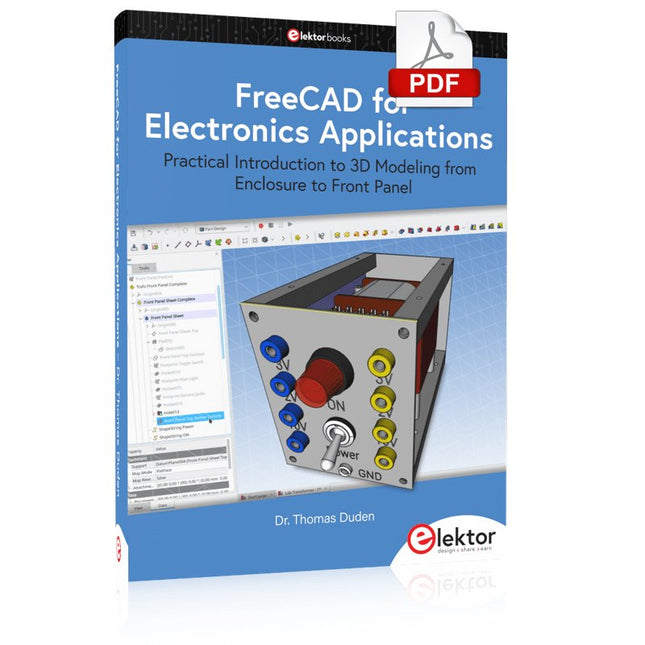
Elektor Digital FreeCAD for Electronic Applications (E-book)
Practical Introduction to 3D Modeling from Enclosure to Front Panel Embedding a vintage component, creating a professional looking home for a circuit board, or even designing a complex apparatus complete with a chassis – these and many other challenges turn into a stimulating pleasure with FreeCAD. Once you have internalized the basic processes, there are virtually no limits to your imagination. Starting to use a new software is never straightforward – especially with a tool as versatile as FreeCAD. Manageable, but at the same time easily usable individual components provide the starting point in this book. Putting these components together later results in assemblies. In the FreeCAD universe, a workable trajectory is demonstrated. The described procedure is illustrative so the examples are easily applied to custom tasks. The devices were made by the author and illustrated with photos. Creating a 3D design is requiring some effort but the initial investment pays off soon. Besides the impressive spatial representation of the projects, the extracted drawings yield a solid base for documentation and production. Extended FreeCAD capabilities like the unfolding of sheet metal parts enormously add to efficiency and pushes models forward into practical assembly. Soon you will definitely not want to do without FreeCAD!
€ 34,95
Members € 27,96
-
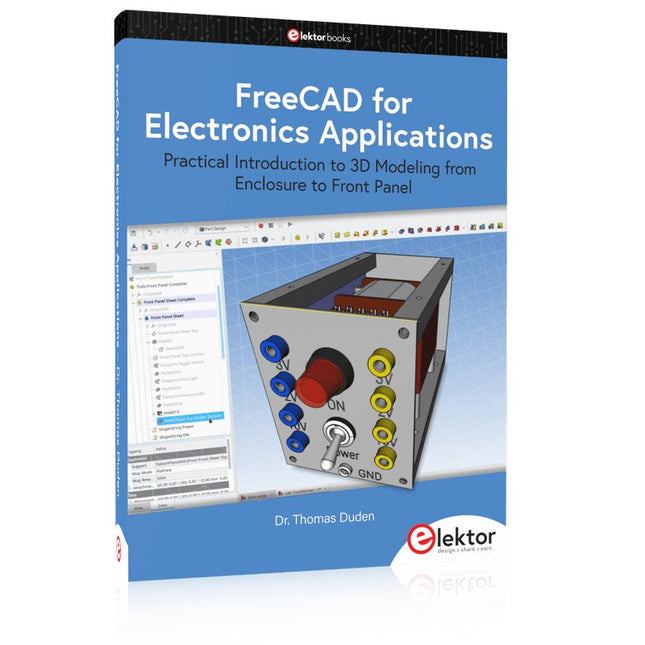
Elektor Publishing FreeCAD for Electronics Applications
Practical Introduction to 3D Modeling from Enclosure to Front Panel Embedding a vintage component, creating a professional looking home for a circuit board, or even designing a complex apparatus complete with a chassis – these and many other challenges turn into a stimulating pleasure with FreeCAD. Once you have internalized the basic processes, there are virtually no limits to your imagination. Starting to use a new software is never straightforward – especially with a tool as versatile as FreeCAD. Manageable, but at the same time easily usable individual components provide the starting point in this book. Putting these components together later results in assemblies. In the FreeCAD universe, a workable trajectory is demonstrated. The described procedure is illustrative so the examples are easily applied to custom tasks. The devices were made by the author and illustrated with photos. Creating a 3D design is requiring some effort but the initial investment pays off soon. Besides the impressive spatial representation of the projects, the extracted drawings yield a solid base for documentation and production. Extended FreeCAD capabilities like the unfolding of sheet metal parts enormously add to efficiency and pushes models forward into practical assembly. Soon you will definitely not want to do without FreeCAD!
€ 44,95
Members € 40,46
-
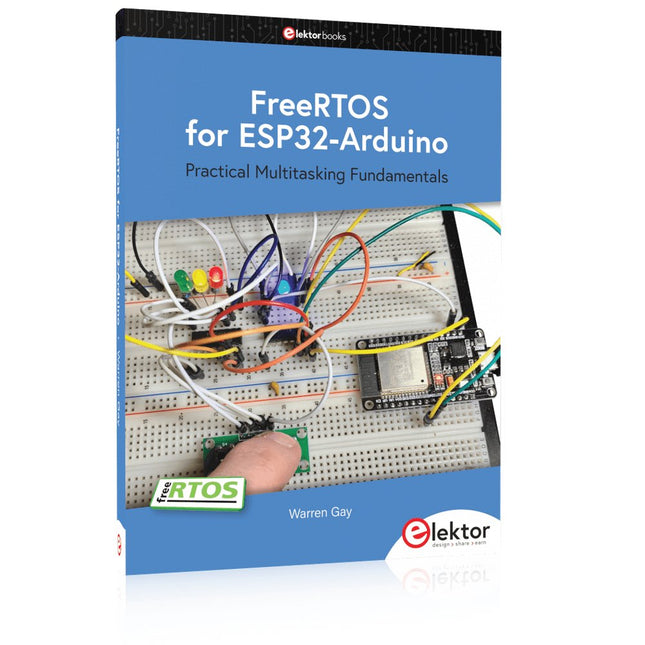
Elektor Publishing FreeRTOS for ESP32-Arduino
Practical Multitasking Fundamentals Programming embedded systems is difficult because of resource constraints and limited debugging facilities. Why develop your own Real-Time Operating System (RTOS) as well as your application when the proven FreeRTOS software is freely available? Why not start with a validated foundation? Every software developer knows that you must divide a difficult problem into smaller ones to conquer it. Using separate preemptive tasks and FreeRTOS communication mechanisms, a clean separation of functions is achieved within the entire application. This results in safe and maintainable designs. Practicing engineers and students alike can use this book and the ESP32 Arduino environment to wade into FreeRTOS concepts at a comfortable pace. The well-organized text enables you to master each concept before starting the next chapter. Practical breadboard experiments and schematics are included to bring the lessons home. Experience is the best teacher. Each chapter includes exercises to test your knowledge. The coverage of the FreeRTOS Application Programming Interface (API) is complete for the ESP32 Arduino environment. You can apply what you learn to other FreeRTOS environments, including Espressif’s ESP-IDF. The source code is available from GitHub. All of these resources put you in the driver’s seat when it is time to develop your next uber-cool ESP32 project. What you will learn: How preemptive scheduling works within FreeRTOS The Arduino startup “loopTask” Message queues FreeRTOS timers and the IDLE task The semaphore, mutex, and their differences The mailbox and its application Real-time task priorities and its effect Interrupt interaction and use with FreeRTOS Queue sets Notifying tasks with events Event groups Critical sections Task local storage The gatekeeper task
-

Elektor Digital FreeRTOS for ESP32-Arduino (E-book)
Practical Multitasking Fundamentals Programming embedded systems is difficult because of resource constraints and limited debugging facilities. Why develop your own Real-Time Operating System (RTOS) as well as your application when the proven FreeRTOS software is freely available? Why not start with a validated foundation? Every software developer knows that you must divide a difficult problem into smaller ones to conquer it. Using separate preemptive tasks and FreeRTOS communication mechanisms, a clean separation of functions is achieved within the entire application. This results in safe and maintainable designs. Practicing engineers and students alike can use this book and the ESP32 Arduino environment to wade into FreeRTOS concepts at a comfortable pace. The well-organized text enables you to master each concept before starting the next chapter. Practical breadboard experiments and schematics are included to bring the lessons home. Experience is the best teacher. Each chapter includes exercises to test your knowledge. The coverage of the FreeRTOS Application Programming Interface (API) is complete for the ESP32 Arduino environment. You can apply what you learn to other FreeRTOS environments, including Espressif’s ESP-IDF. The source code is available from GitHub. All of these resources put you in the driver’s seat when it is time to develop your next uber-cool ESP32 project. What you will learn: How preemptive scheduling works within FreeRTOS The Arduino startup “loopTask” Message queues FreeRTOS timers and the IDLE task The semaphore, mutex, and their differences The mailbox and its application Real-time task priorities and its effect Interrupt interaction and use with FreeRTOS Queue sets Notifying tasks with events Event groups Critical sections Task local storage The gatekeeper task
€ 34,95
Members € 27,96
-

FTDI FTDI Serial TTL RS232 USB Cable
This FTDI USB to TTL (3.3 V I/O) Serial Cable (FTDI TTL-232R-3V3 OEM) is a professional, high quality, high speed device which allows a simple and easy way to connect TTL interface devices using a spare USB port. Features TTL-232R-3V3 FTDI USB to TTL 3.3 V Serial Cable FTDI TTL-232R-3V3 Cable 6 Way The FTDI USB to TTL 3.3 V features a FTDI FT232R device integrated within the cable FTDI USB to TTL Serial 3.3 V Adapter Cable 6 Pin 0.1' Female Socket Header UART IC FT232RL Chip Compatible with Windows 7/8/10 and Linux
€ 19,95
Members € 17,96
-
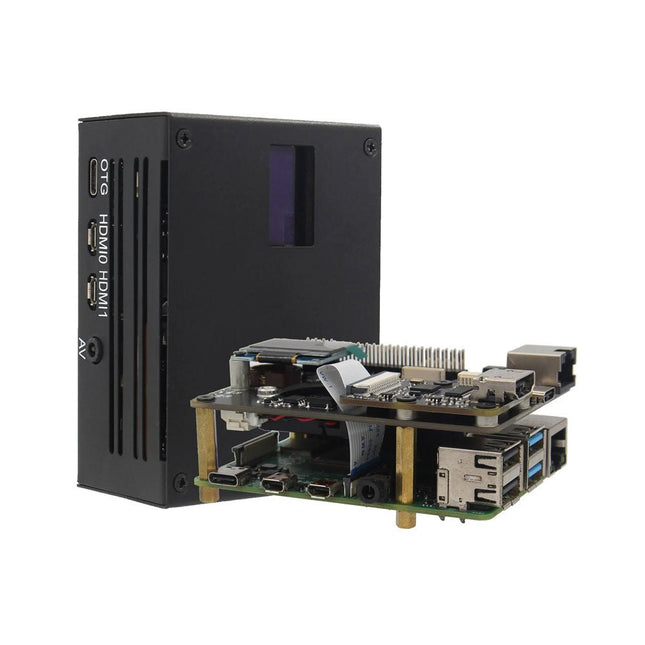
Geekworm Geekworm KVM-A3 Kit for Raspberry Pi 4
KVM stands for Keyboard, Video, and Mouse and it is a powerful open-source software that enables remote access via Raspberry Pi. This KVM-A3 kit is designed based on the Raspberry Pi 4. With it, you can turn your computer on or off, restart it, configure the UEFI/BIOS, and even reinstall the operating system using a virtual CD-ROM or flash drive. You can either use your own remote keyboard and mouse, or let KVM simulate a keyboard, mouse, and monitor – presented through a web browser as if you were directly interacting with the remote system. It's true hardware-level access with no dependency on remote ports, protocols, or services! Features Designed especially for KVM (an open and affordable DIY IP-KVM based on Raspberry Pi) Compatible with Raspberry Pi 4 (not included) Fully compatible with PiKVM V3 OS Control a server or computer using a web browser HDMI Full HD capture based on the TC358743 chip OTG keyboard and mouse support; mass storage drive emulation Hardware Real-Time Clock (RTC) with CR1220 coin battery socket Equipped with a cooling fan to dissipate heat from the Raspberry Pi Features solid-state relays to protect Raspberry Pi GPIO pins from computer and ESD spikes ATX control via RJ45 connector: switch the machine on or off, reset it, and monitor HDD and power LED status remotely 10-pin SH1.0 connector reserved for future I²S HDMI audio support 4-pin header and spacers reserved for I²C OLED display Included KVM-A3 Metal Case for Raspberry Pi 4 X630 HDMI to CSI-2 Module (for video capture) X630-A3 Expansion Board (provides Ethernet, cooling, RTC, power input, etc.) X630-A5 Adapter Board (installed inside the PC case; connects the computer motherboard to the IO panel cable of the PC case) 0.96-inch OLED Display (128 x 64 pixels) Ethernet Cable (TIA/EIA-568.B standard; also serves as the ATX control signal cable) Downloads Wiki PiKVM OS
-
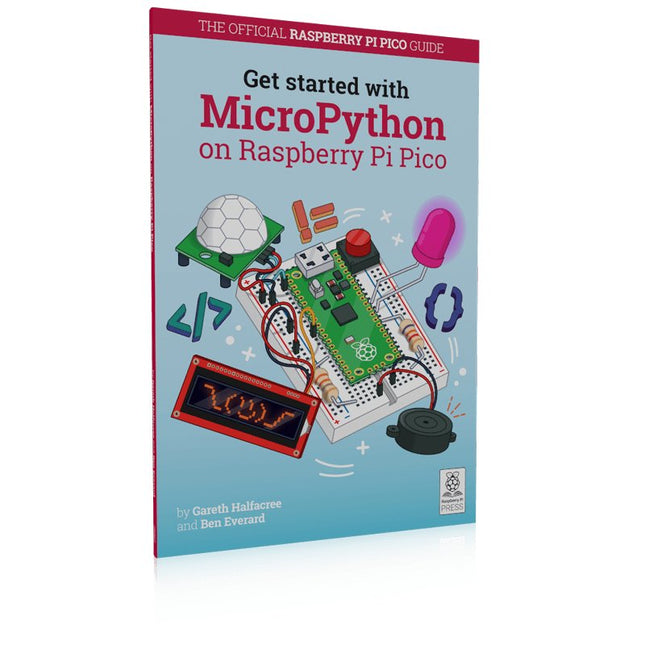
Raspberry Pi Foundation Get Started with MicroPython on Raspberry Pi Pico
In Get Started with MicroPython on Raspberry Pi Pico, you will learn how to use the beginner-friendly language MicroPython to write programs and connect up hardware to make your Raspberry Pi Pico interact with the world around it. Using these skills, you can create your own electro‑mechanical projects, whether for fun or to make your life easier. Microcontrollers, like RP2040 at the heart of Raspberry Pi Pico, are computers stripped back to their bare essentials. You don’t use monitors or keyboards, but program them to take their input from, and send their output to the input/output pins. Using these programmable connections, you can light lights, make noises, send text to screens, and much more. In Get Started with MicroPython on Raspberry Pi Pico, you will learn how to use the beginner-friendly language MicroPython to write programs and connect up hardware to make your Raspberry Pi Pico interact with the world around it. Using these skills, you can create your own electro‑mechanical projects, whether for fun or to make your life easier. The robotic future is here – you just have to build it yourself. We’ll show you how. About the authors Gareth Halfacree is a freelance technology journalist, writer, and former system administrator in the education sector. With a passion for open-source software and hardware, he was an early adopter of the Raspberry Pi platform and has written several publications on its capabilities and flexibility. Ben Everard is a geek who has stumbled into a career that lets him play with new hardware. As the editor of HackSpace magazine, he spends more time than he really should experimenting with the latest (and not-solatest) DIY tech.
€ 19,95€ 9,95
Members identical
-
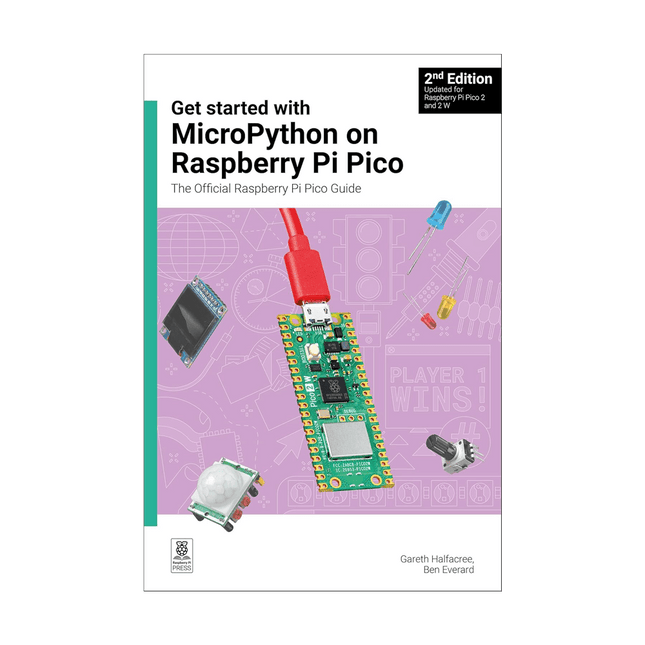
Raspberry Pi Foundation Get Started with MicroPython on Raspberry Pi Pico (2nd Edition)
Fully updated for Raspberry Pi Pico W, this book gets you started with Raspberry Pi Pico – whether you’re using Raspberry Pi Pico for a home project, industrial automation, or learning (or teaching!) electronics and programming. Microcontrollers, like the RP2040 chip at the heart of Raspberry Pi Pico, are computers stripped back to their bare essentials. You don’t use monitors or keyboards with them – instead, you program them over USB to take their input from (and send their output to) on-board input/output pins. Using these programmable connections, you can light LEDs, make noises, send text to screens, and much more. In this book, you will learn how to use the beginner-friendly MicroPython language to write programs, and you’ll connect up hardware to make your Raspberry Pi Pico interact with the world around it. Using these skills, you can create your own electromechanical projects, whether for fun or to make your life easier. Fully updated for Raspberry Pi Pico W and the latest version of MicroPython, this book shows you how to: Get started with Raspberry Pi Pico and Pico W Work with various electronic components Create your own programmable electronic contraptions Turn Raspberry Pi Pico W into a network-connected node for the Internet of Things Link your Pico W to your smartphone, tablet, or another Pico W with Bluetooth Low Energy (BLE) Whether you’re using Raspberry Pi Pico for a home project, industrial automation, or learning (or teaching!) electronics and programming, this book will show you how.
-

Elektor Bundles Get Started with the NXP FRDM-MCXN947 Development Board (Bundle)
This bundle contains: Book: Get Started with the NXP FRDM-MCXN947 Development Board (normal price: €40) NXP FRDM-MCXN947 Development Board (normal price: €30) Book: Get Started with the NXP FRDM-MCXN947 Development Board Develop projects on connectivity, graphics, machine learning, motor control, and sensors This book is about the use of the FRDM-MCXN947 Development Board, developed by NXP Semiconductors. It integrates the dual Arm Cortex-M33, operating at up to 150 MHz. Ideal for Industrial, IoT, and machine learning applications. It features Hi-Speed USB, CAN 2.0, I³C and 10/100 Ethernet. The board includes an on-board MCU-Link debugger, FlexI/O for LCD control, and dual-bank flash for read-while-write operations, supporting large external serial memory configurations. One of the important features of the development board is that it features an integrated eIQ Neutron Neural Processing Unit (NPU), thus enabling users to develop AI-based projects. The development board also supports Arduino Uno form factor header pins, making it compatible with many Arduino shields, mikroBUS connector for MikroElektronika Click Boards, and Pmod connector. One of the nice things of the FRDM-MCXN947 development board is that it includes several on-board debug probes, allowing programmers to debug their programs by communicating directly with the MCU. With the help of the debugger, programmers can single-step through a program, insert breakpoints, view and modify variables and so on. Many working and tested projects have been developed in the book using the popular MCUXpresso IDE and the SDK with various sensors and actuators. Use of the popular CMSIS-DSP library is also explained with several commonly used matrix operations. The projects provided in the book can be used without any modifications in many applications. Alternatively, readers can base their projects on those given in the book during the development of their own projects. NXP FRDM-MCXN947 Development Board The FRDM-MCXN947 is a compact and versatile development board designed for rapid prototyping with MCX N94 and N54 microcontrollers. It features industry-standard headers for easy access to the MCU's I/Os, integrated open-standard serial interfaces, external flash memory, and an onboard MCU-Link debugger. Specifications Microcontroller MCX-N947 Dual Arm Cortex-M33 cores @ 150 MHz each with optimized performance efficiency, up to 2 MB dual-bank flash with optional full ECC RAM, External flash Accelerators: Neural Processing Unit, PowerQuad, Smart DMA, etc. Memory Expansion *DNP Micro SD card socket Connectivity Ethernet Phy and connector HS USB-C connectors SPI/I²C/UART connector (PMOD/mikroBUS, DNP) WiFi connector (PMOD/mikroBUS, DNP) CAN-FD transceiver Debug On-board MCU-Link debugger with CMSIS-DAP JTAG/SWD connector Sensor P3T1755 I³C/I²C Temp Sensor, Touch Pad Expansion Options Arduino Header (with FRDM expansion rows) FRDM Header FlexIO/LCD Header SmartDMA/Camera Header Pmod *DNP mikroBUS User Interface RGB user LED, plus Reset, ISP, Wakeup buttons Included 1x FRDM-MCXN947 Development Board 1x USB-C Cable 1x Quick Start Guide Downloads Datasheet Block diagram
€ 69,95€ 29,95
Members identical
-
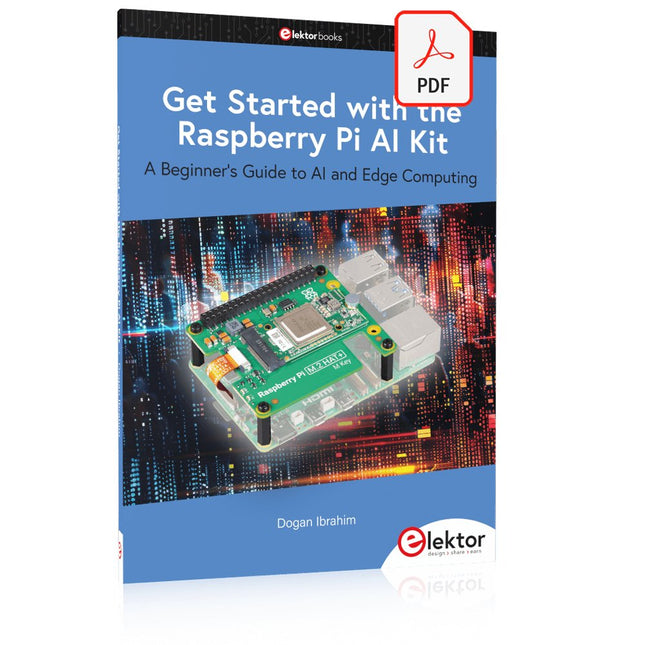
Elektor Digital Get Started with the Raspberry Pi AI Kit (E-book)
A Beginner's Guide to AI and Edge Computing Artificial Intelligence (AI) is now part of our daily lives. With companies developing low-cost AI-powered hardware into their products, it is now becoming a reality to purchase AI accelerator hardware at comparatively very low costs. One such hardware accelerator is the Hailo module which is fully compatible with the Raspberry Pi 5. The Raspberry Pi AI Kit is a cleverly designed hardware as it bundles an M.2-based Hailo-8L accelerator with the Raspberry Pi M.2 HAT+ to offer high speed inferencing on the Raspberry Pi 5. Using the Raspberry Pi AI Kit, you can build complex AI-based vision applications, running in real-time, such as object detection, pose estimation, instance segmentation, home automation, security, robotics, and many more neural network-based applications. This book is an introduction to the Raspberry Pi AI Kit, and it is aimed to provide some help to readers who are new to the kit and wanting to run some simple AI-based visual models on their Raspberry Pi 5 computers. The book is not meant to cover the detailed process of model creation and compilation, which is done on an Ubuntu computer with massive disk space and 32 GB memory. Examples of pre-trained and custom object detection are given in the book. Two fully tested and working projects are given in the book. The first project explains how a person can be detected and how an LED can be activated after the detection, and how the detection can be acknowledged by pressing an external button. The second project illustrates how a person can be detected, and how this information can be passed to a smart phone over a Wi-Fi link, as well as how the detection can be acknowledged by sending a message from the smartphone to your Raspberry Pi 5.
€ 29,95
Members € 23,96
-

Elektor Digital Getting Started with ESPHome (E-book)
Develop your own custom home automation devices Espressif's ESP8266 and ESP32 microcontrollers have brought DIY home automation to the masses. However, not everyone is fluent in programming these microcontrollers with Espressif's C/C++ SDK, the Arduino core, or MicroPython. This is where ESPHome comes into its own: with this project, you don’t program your microcontroller but configure it. This book demonstrates how to create your own home automation devices with ESPHome on an ESP32 microcontroller board. You’ll learn how to combine all kinds of electronic components and automate complex behaviours. Your devices can work completely autonomously, and connect over Wi-Fi to your home automation gateways such as Home Assistant or MQTT broker. By the end of this book, you will be able to create your own custom home automation devices the way you want. Thanks to ESPHome and the ESP32, this is within everyone’s grasp. Set up an ESPHome development environment and create maintainable configurations Use buttons and LEDs Sound a buzzer and play melodies Read measurements from various types of sensors Communicate over a short distance with NFC, infrared light, and Bluetooth Low Energy Show information on various types of displays Downloads Software
€ 29,95
Members € 23,96
-
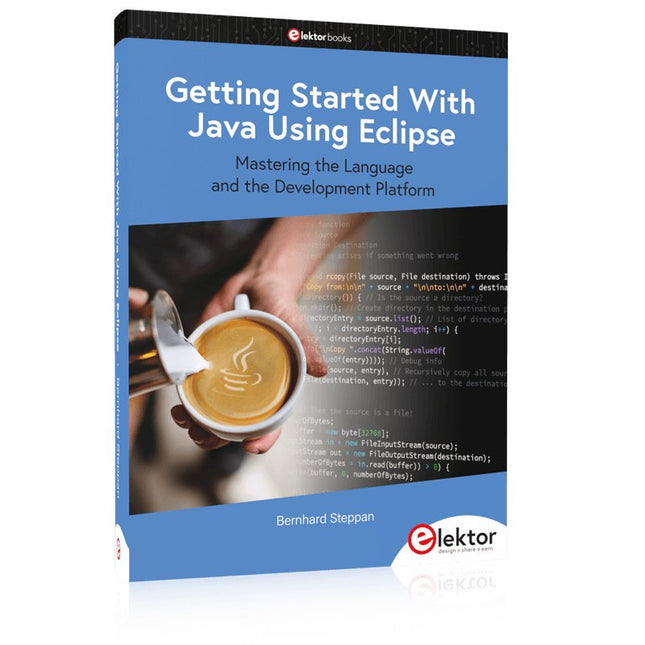
Elektor Publishing Getting Started With Java Using Eclipse
Mastering the Language and the Development Platform Many people would like to learn Java but getting started is not easy since programming with Java requires at least two things: mastering the programming language and the development environment. With the help of many examples, this book shows how the language is structured. In addition, it employs the Eclipse development environment as an example of a powerful tool to teach developing Java programs. In Basics, the first part of the book, you acquire your Java and Eclipse basic knowledge. This part lays the programming foundations, gives you an overview of Java technology, and shows you what is special about object-oriented programming. In the second part called Java Language, everything revolves around the subtleties of the Java language and this is where the first small Java applications are created, aided by a fine blend of the knowledge part and practical exercises. Java Technology is both the name and the focus of the third part which also introduces you to the rules to observe when programming, what class libraries are and what advantages they have. In addition, you will learn how to test programs, what algorithms are, and how to program them. The fourth part, Java Projects, enables you to apply all the previous elements in an application with a graphical user interface. The project shows how to develop a larger application piece by piece with the Eclipse development environment. The Appendix concludes with a section on frequent errors that can occur when working with Eclipse, and a Glossary.
€ 44,95
Members € 40,46
-

Elektor Digital Getting Started With Java Using Eclipse (E-book)
Mastering the Language and the Development Platform Many people would like to learn Java but getting started is not easy since programming with Java requires at least two things: mastering the programming language and the development environment. With the help of many examples, this book shows how the language is structured. In addition, it employs the Eclipse development environment as an example of a powerful tool to teach developing Java programs. In Basics, the first part of the book, you acquire your Java and Eclipse basic knowledge. This part lays the programming foundations, gives you an overview of Java technology, and shows you what is special about object-oriented programming. In the second part called Java Language, everything revolves around the subtleties of the Java language and this is where the first small Java applications are created, aided by a fine blend of the knowledge part and practical exercises. Java Technology is both the name and the focus of the third part which also introduces you to the rules to observe when programming, what class libraries are and what advantages they have. In addition, you will learn how to test programs, what algorithms are, and how to program them. The fourth part, Java Projects, enables you to apply all the previous elements in an application with a graphical user interface. The project shows how to develop a larger application piece by piece with the Eclipse development environment. The Appendix concludes with a section on frequent errors that can occur when working with Eclipse, and a Glossary.
€ 34,95
Members € 27,96
-

Elektor Digital Getting Started with the Intel Edison (E-book)
The Internet of Things is rapidly gaining interest, and that has fueled the development of the Edison. A tiny computer, the size of a postage stamp, with a lot of power and built-in wireless communication capabilities. In this eBook we will help you get up-to-speed with the Edison, by installing the software both on the Edison as well as on your Windows PC. We will use the Edison Arduino break-out board because it is easy to work with. We will discuss Linux, Arduino C++ and Python, and show examples of how the Edison can interface with other hardware. We will use Wi-Fi and Bluetooth to set up wireless connections, and show you a trick to program sketches over Wi-Fi. Once you have completed this book your Edison will be up and running with the latest software version, and you will have sufficient knowledge of both hardware and software to start making your own applications. You will even be able to program the Edison over USB and wireless both in Arduino C++ and Python. This is not a projects eBook, but a toolbox that will allow you to explore the wonderful world of the Intel Edison!
€ 24,95
Members € 19,96
-

Google Google Coral USB Accelerator
The Google Coral USB Accelerator adds an Edge TPU coprocessor to your system, enabling high-speed machine learning inferencing on a wide range of systems, simply by connecting it to a USB port. Features Supported host OS: Debian Linux, macOS, Windows 10 Compatible with Raspberry Pi boards Supported Framework: TensorFlow Lite Performs high-speed ML inferencing The on-board Edge TPU coprocessor is capable of performing 4 trillion operations (tera-operations) per second (TOPS), using 0.5 watts for each TOPS (2 TOPS per watt). For example, it can execute state-of-the-art mobile vision models such as MobileNet v2 at almost 400 FPS, in a power-efficient manner. Supports all major platforms Connects via USB to any system running Debian Linux (including Raspberry Pi), macOS, or Windows 10. Supports TensorFlow Lite No need to build models from the ground up. TensorFlow Lite models can be compiled to run on the Edge TPU. Supports AutoML Vision Edge Easily build and deploy fast, high-accuracy custom image classification models to your device with AutoML Vision Edge. Specifications ML accelerator Google Edge TPU coprocessor:4 TOPS (int8); 2 TOPS per watt Connector USB 3.0 Type-C (data/power) Dimensions 65 x 30 mm Downloads/Documentation Datasheet Get started with the USB Accelerator Model compatibility on the Edge TPU Edge TPU inferencing overview Run multiple models with multiple Edge TPUs Pipeline a model with multiple Edge TPUs PyCoral API (Python) Libcoral API (C++) Libedgetpu API (C++) Edge TPU compiler Pre-compiled models All software downloads
-
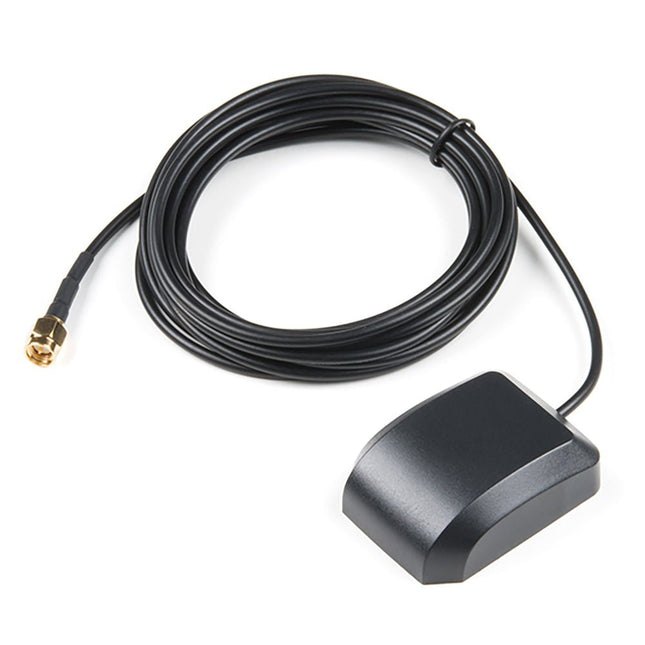
SparkFun GPS/GNSS Magnetic Mount Antenna - 3 m (SMA)
This exceptional GPS/GNSS antenna is designed for both GPS and GLONASS reception. The magnetic mount allows it to be easily mounted to a metal base such as a ground plate or car roof. The antenna is terminated with a 3m cable and standard SMA connector. Features Dimensions: 50x38x17mm Weight: 75g including 3m cable Frequency Range: 1575 - 1610MHz GPS Center Frequency: 1575.42MHz GLONASS Center Frequency: 1602MHz LNA Voltage: 3 to 5VDC LNA Gain: 28dB LNA Current: 10mA Termination Connector: SMA Impedance: 50Ω Right-hand polarization Cable Length: 3 meter
-
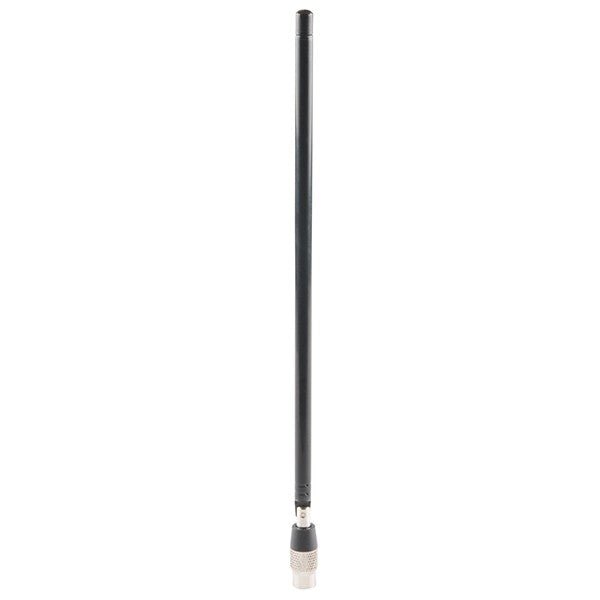
Great Scott Gadgets Great Scott Gadgets ANT500 Telescopic Antenna (75 MHz to 1 GHz)
ANT500 from Great Scott Gadgets is a telescopic antenna designed for operation from 75 MHz to 1 GHz. Its total length is configurable from 20 cm to 88 cm. ANT500 is constructed of stainless steel and features an SMA male connector, rotating shaft, and adjustable elbow. ANT500 is a 50 ohm general purpose antenna. It is the perfect first antenna for use with HackRF One.
-
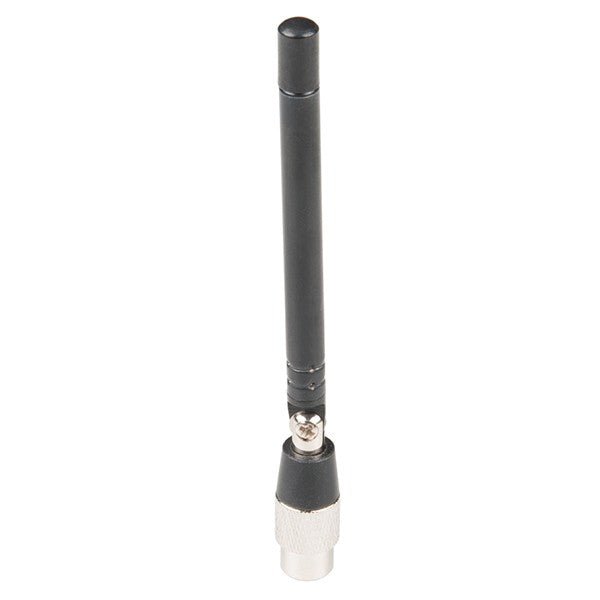
Great Scott Gadgets Great Scott Gadgets ANT700 Telescopic Antenna (300 MHz to 1100 MHz)
ANT700 from Great Scott Gadgets is a lightweight telescopic antenna designed for operation from 300 MHz to 1100 MHz. Its total length is configurable from 9.5 cm to 24.5 cm. ANT700 is constructed of stainless steel and features an SMA male connector, rotating shaft, and adjustable elbow. ANT700 is a 50 ohm general purpose antenna. It is a perfect first antenna for use with HackRF One.
-

Great Scott Gadgets Great Scott Gadgets Cynthion USB Analyzer
Multi-tool for Building, Analyzing, and Hacking USB Devices Cynthion is an all-in-one tool for building, testing, monitoring, and experimenting with USB devices. Built around a unique FPGA-based architecture, Cynthion’s digital hardware can be fully customized to suit the application at hand. As a result, it can act as a no-compromise High-Speed USB protocol analyzer, a USB research multi-tool, or a USB development platform. Out-of-the-box, Cynthion acts as a USB protocol analyzer capable of capturing and analyzing traffic between a host and any Low-, Full-, or High-Speed ("USB 2.0") USB device. It works seamlessly with the open-source analysis software Packetry. Combined with the LUNA gateware and Facedancer libraries, Cynthion becomes a versatile USB research and development tool. Facedancer makes it quick and easy to create or experiment with real USB devices—not just emulations—even if you don’t have experience with digital hardware design, HDL, or FPGA architecture! Features Cynthion is a fully reconfigurable test instrument that provides all the hardware, gateware, firmware, and software you need to work with—and, indeed, tob master-USB. Below are a few of the challenges to which you can apply your Cynthion: Protocol analysis for Low-, Full-, and High-speed USB: Cynthion provides everything you need for passive USB monitoring. With the Packetry USB analysis software, Cynthion provides everything you need for passive USB monitoring. Creating your own Low-, Full-, or High-speed USB device: LUNA provides Amaranth gateware that allows you to create USB devices in gateware, firmware, or a combination of the two. Using the Facedancer library, you can create or emulate real USB devices in high-level Python. Meddler-in-the-Middle (MitM) attacks on USB communication: Cynthion hardware can function as a "USB proxy" capable of transparently modifying USB data as it flows between a host and a device. Each board’s three USB-C connections allow for simultaneous, high-speed proxying while maintaining a high-speed connection to the host. As a result, you can proxy a connection with or without the help of a host PC. USB reverse engineering and security research: Cynthion hardware and LUNA gateware represent a purpose-built backend for research tools like Facedancer and USB-fuzzing libraries, thereby simplifying the emulation and rapid prototyping of compliant and non-compliant USB devices. Unlike other USB-emulation solutions, Cynthion-based hardware is dynamically reconfigurable, so it gives you the flexibility to create any endpoint configuration and engage in almost any USB (mis)behavior. Specifications A Lattice Semiconductor LFE5U-12F ECP5 FPGA supported by the yosys+nextpnr open-source FPGA flow Three High-Speed USB interfaces, each connected to a USB3343 PHY capable of operating at up to 480 Mbps. Two USB-C connectors for device-mode communication (left side) One USB-C connector for host-mode communication, device-mode communication, or USB analysis (right-side) One USB-A connector for host-mode communication or USB analysis (right-side, shared with USB-C connector) A Microchip SAMD11 debug controller allows user configuration of the FPGA and provides a number of diagnostic interfaces. A complete, user-programmable JTAG controller capable of configuring the FPGA and communicating via JTAG with user designs A built-in USB-to-serial communications bridge for FPGA debug I/O A variety of simple, built-in debug mechanisms, including utilities that allow you to create simple, PC-accessible register interfaces Three USB power switches allow you to control power to and from the right-side USB connectors, thereby facilitating controlled power cycling of USB-powered devices under analysis. 64 Mbit (8 MiB) RAM for buffering USB traffic or for user applications Two Digilent Pmod Compatible I/O connectors presenting 16 high-speed FPGA user IOs that support user FPGA applications 32 Mbit (4 MiB) SPI-connected flash for PC-less FPGA configuration Six FPGA-connected user LEDs and five microcontroller-managed status LEDs A PAC1954 4-channel I²C power monitor IC, to measure VBUS voltages and currents on all four Cynthion USB ports. Two FUSB302B I²C USB-C port controllers, for the AUX and TARGET-C ports, to support USB Power Delivery or custom USB-C behaviour. Downloads Documentation Hardware Design Files Schematic, Diagrams & Software
-

Great Scott Gadgets Great Scott Gadgets GreatFET One Universal USB
GreatFET One is a hardware hacker’s best friend. With an extensible, open source design, two USB ports, and 100 expansion pins, GreatFET One is your essential gadget for hacking, making, and reverse engineering. By adding expansion boards called neighbors, you can turn GreatFET One into a USB peripheral that does almost anything.Whether you need an interface to an external chip, a logic analyzer, a debugger, or just a whole lot of pins to bit-bang, the versatile GreatFET One is the tool for you. Hi-Speed USB and a Python API allow GreatFET One to become your custom USB interface to the physical world.Features Serial protocols: SPI, I²C, UART, and JTAG Programmable digital I/O Analog I/O (ADC/DAC) Logic analysis Debugging Data acquisition Four LEDs Versatile USB functions High-throughput hardware-assisted streaming serial engine Downloads Documentation GitHub
-

Great Scott Gadgets Great Scott Gadgets HackRF One SDR (1 MHz to 6 GHz)
HackRF One is a Software Defined Radio (SDR) peripheral capable of transmission or reception of radio signals from 1 MHz to 6 GHz. Designed to enable test and development of modern and next generation radio technologies, HackRF One is an open source hardware platform that can be used as a USB peripheral or programmed for stand-alone operation. Specifications 1 MHz to 6 GHz operating frequency Half-duplex transceiver Up to 20 million samples per second 8-bit quadrature samples (8-bit I and 8-bit Q) Compatible with GNU Radio, SDR and more Software-configurable RX and TX gain and baseband filter Software-controlled antenna port power (50 mA at 3.3 V) SMA female antenna connector SMA female clock input and output for synchronization Convenient buttons for programming Internal pin headers for expansion Hi-Speed USB 2.0 USB-powered Open source hardware HackRF One is test equipment for RF systems. It has not been tested for compliance with regulations governing transmission of radio signals. You are responsible for using your HackRF One legally. Included 1x HackRF One SDR 1x Plastic enclosure 1x micro-USB cable Note: An antenna is not included. ANT500 is recommended as a starter antenna for HackRF One. Downloads Documentation GitHub Source code and hardware design files
-
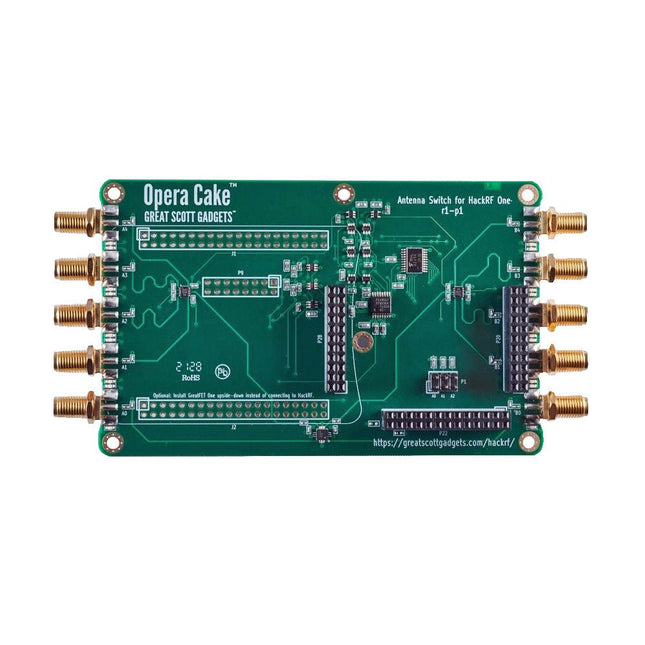
Great Scott Gadgets Great Scott Gadgets Opera Cake (Antenna Switch for HackRF One)
Opera Cake is an antenna switching add-on board for HackRF One that is configured with command-line software either manually, or for automated port switching based on frequency or time. It has two primary ports, each connected to any of eight secondary ports, and is optimized for use as a pair of 1x4 switches or as a single 1x8 switch. Its recommended frequency range is 1 MHz to 4 GHz. When HackRF One is used to transmit, Opera Cake can automatically route its output to the appropriate transmit antennas, as well as any external filters, amplifiers, etc. No changes are needed to the existing SDR software, but full control from the host is available. Opera Cake also enhances the HackRF One’s use as a spectrum analyzer across its entire operating frequency range of 1 MHz to 4 GHz. Antenna switching works with the existing hackrf_sweep feature, which can sweep the whole tuning range in less than a second. Automatic switching mid-sweep enables the use of multiple antennas when sweeping a wide frequency range. Downloads Documentation GitHub
-

Great Scott Gadgets Great Scott Gadgets Throwing Star LAN Tap Pro
The Throwing Star LAN Tap Pro is a passive Ethernet tap, requiring no power for operation. There are active methods of tapping Ethernet connections (e.g., a mirror port on a switch), but none can beat passive taps for portability. To the target network, the Throwing Star LAN Tap looks just like a section of cable, but the wires in the cable extend to the monitoring ports in addition to connecting one target port to the other.The monitoring ports (J3 and J4) are receive-only; they connect to the receive data lines on the monitoring station but do not connect to the station’s transmit lines. This makes it impossible for the monitoring station to accidentally transmit data packets onto the target network.The Throwing Star LAN Tap Pro is designed to monitor 10BASET and 100BASETX networks. It is not possible for an unpowered tap to perform monitoring of 1000BASET (Gigabit Ethernet) networks, so the Throwing Star LAN Tap intentionally degrades the quality of 1000BASET target networks, forcing them to negotiate a lower speed (typically 100BASETX) that can be passively monitored. This is the purpose of the two capacitors (C1 and C2).Like all passive LAN Taps, the Throwing Star LAN Tap Pro degrades signal quality to some extent. Except as described above for Gigabit networks, this rarely causes problems on the target network. In situations where very long cables are in use, the signal degradation could reduce network performance. It is a good practice to use cables that are not any longer than necessary.DownloadsOpen source design files
-
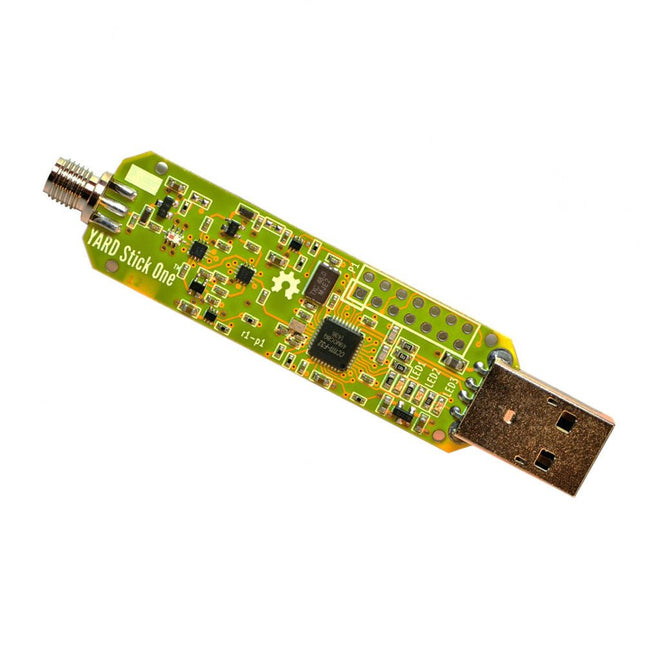
Great Scott Gadgets Great Scott Gadgets YARD Stick One – Sub-1 GHz Wireless Test Tool
YARD Stick One (Yet Another Radio Dongle) is a sub-1 GHz wireless transceiver IC on a USB dongle. It is based on the Texas Instruments CC1111. YARD Stick One can transmit or receive digital wireless signals at frequencies below 1 GHz. It uses the same radio circuit as the popular IM-Me. The radio functions that are possible by customizing IM-Me firmware are now at your fingertips when you attach YARD Stick One to a computer via USB. Features Half-duplex transmit and receive Official operating frequencies: 300-348 MHz, 391-464 MHz, and 782-928 MHz Unofficial operating frequencies: 281-361 MHz, 378-481 MHz, and 749-962 MHz Modulations: ASK, OOK, GFSK, 2-FSK, 4-FSK, MSK Data rates up to 500 kbps Full-Speed USB 2.0 SMA female antenna connector (50 ohms) Software-controlled antenna port power (max 50 mA at 3.3 V) Low pass filter for elimination of harmonics when operating in the 800 and 900 MHz bands GoodFET-compatible expansion and programming header GIMME-compatible programming test points Open source Downloads Documentation GitHub
€ 99,95€ 49,95
Members identical























